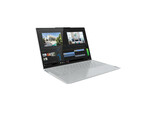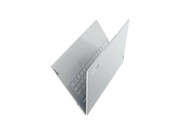Lenovo Yoga Slim 7 Carbon 14ACN6, 5800U
Specifiche tecniche

Price comparison
Media dei 4 punteggi (dalle 6 recensioni)
recensioni per Lenovo Yoga Slim 7 Carbon 14ACN6, 5800U
Sorgente: Think Computers
 EN→IT Archive.org version
EN→IT Archive.org versionWhen I was looking up pricing for this laptop it actually turns out it is “temporally unavailable” on the Lenovo website. I am not sure if this is due to a chip shortage or what, but the last available price I was able to find for this specific unit was $949, which I feel is a great price! If AMD is going to continue to offer affordable and competitive mobile CPU solutions we are going to see some really great laptops in the future. Overall ThinkComputers gives the Lenovo IdeaPad Slim 7 Carbon a 9 out of 10 score.
Singola recensione, disponibile online, Lunghissimo, Data: 05/24/2022
Valutazione: Punteggio totale: 90%
Sorgente: PC Mag
 EN→IT Archive.org version
EN→IT Archive.org versionWe've stated that Lenovo's ThinkPad X1 Carbon and Dell's XPS 13 OLED are the two best laptops in the world. Its subpar keyboard keeps the IdeaPad Slim 7 Carbon from joining them, but it's not far behind—getting a slightly larger OLED screen and a handy dongle with HDMI and USB-A ports for $300 less than a comparably equipped Dell is surely tempting. In short, the Carbon cross-breeding (and cross-branding) experiment, from ThinkPad over to IdeaPad, looks like a success out of the gate. The Slim 7 Carbon deserves a spot near the top of the short lists of shoppers hunting for a hot-value ultraportable.
Singola recensione, disponibile online, Medio, Data: 02/08/2022
Valutazione: Punteggio totale: 80%
Sorgente: Unbox
 EN→IT Archive.org version
EN→IT Archive.org versionOur review of the Yoga Slim 7 Carbon shows that Lenovo has an ace up its sleeve in offering a lightweight-yet-powerful ultrabook in the Philippines. The Yoga Slim 7 Carbon is reasonably priced especially if you factor in its premium build and 90hz QHD+ OLED display. Save for the lack of Thunderbolt ports, the Yoga Slim 7 Carbon is a great ultrabook to consider if you are looking for something that balances both being lightweight and powerful enough for most tasks.
Singola recensione, disponibile online, Corto, Data: 12/07/2021
Sorgente: Hardware Zone
 EN→IT Archive.org version
EN→IT Archive.org versionLast year’s Yoga Slim 7i Carbon won our Tech Awards because of its unassailable blend of performance, portability, and price. And this year’s model is equally good because it has these same qualities. Performance has been improved but at no cost to portability, and it even gets an excellent OLED display. Perhaps the most incredible thing of all is that it is priced so competitively. For many readers, I think this can be their perfect notebook. But before you rush to click on the buy button, there’s at least one thing to consider. The Yoga Slim 7 Carbon’s biggest downfall is arguably its lack of Thunderbolt support. Granted, not everyone uses Thunderbolt accessories but it’s nice to have because it opens up a world of possibilities such as crazy-fast external storage, external graphics docks, and feature-packed docks. Less glaring shortcomings include the lack of a 1TB storage option, a dismal webcam, and a somewhat fussy trackpad. Even with its flaws, this is a very complete and solid notebook. There's no doubt that it will be amongst the forerunners in next year’s Best Ultraportable Notebook category.
Singola recensione, disponibile online, Lunghissimo, Data: 11/27/2021
Valutazione: Punteggio totale: 90% prezzo: 90% prestazioni: 85% mobilità: 85% qualità di lavorazione: 85%
Sorgente: Hardware Zone
 EN→IT Archive.org version
EN→IT Archive.org versionLast year’s Yoga Slim 7i Carbon won our Tech Awards because of its unassailable blend of performance, portability, and price. And this year’s model is equally good because it has these same qualities. Performance has been improved but at no cost to portability, and it even gets an excellent OLED display. Perhaps the most incredible thing of all is that it is priced so competitively. For many readers, I think this can be their perfect notebook. But before you rush to click on the buy button, there’s at least one thing to consider. The Yoga Slim 7 Carbon’s biggest downfall is arguably its lack of Thunderbolt support. Granted, not everyone uses Thunderbolt accessories but it’s nice to have because it opens up a world of possibilities such as crazy-fast external storage, external graphics docks, and feature-packed docks. Less glaring shortcomings include the lack of a 1TB storage option, a dismal webcam, and a somewhat fussy trackpad. Even with its flaws, this is a very complete and solid notebook. There's no doubt that it will be amongst the forerunners in next year’s Best Ultraportable Notebook category.
Singola recensione, disponibile online, Medio, Data: 11/19/2021
Valutazione: Punteggio totale: 90% prezzo: 90% prestazioni: 85% mobilità: 85% qualità di lavorazione: 85%
Sorgente: Jagat Review
 ID→IT Archive.org version
ID→IT Archive.org versionSingola recensione, disponibile online, Lunghissimo, Data: 12/01/2021
Commenti
NVIDIA GeForce MX450:
GPU entry level Gimped GeForce GTX 1650 (Turing TU117) con memoria grafica GDDR5 o GDDR6. Disponibile in 4 diverse varianti, dove la LP = versione a bassa potenza con 12 Watt TGP è la più lenta.
Ridurre la distanza delle Schede Grafiche per gli utenti che vogliono utilizzare il videogiochi. I nuovi giochi dovrebbero funzionare su queste schede, ma con riduzione dei dettagli e risoluzione mediocre.
>> Ulteriori informazioni le potete trovare nel nostroConfronto delle schede grafiche e nella nostra Lista dei Benchmark.
R7 5800U:
APU Octa-Core mobile con core Zen 3 con clock da 1,9 GHz a 4,4 GHz e una iGPU Vega con 8 CU con clock fino a 2000 MHz.
>>Ulteriori informazioni le potete trovare nel nostroConfronto dei processori per portatili.




